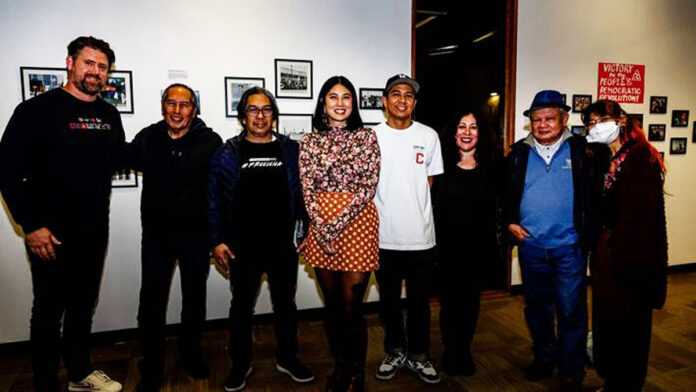
Youth art outreach non-profit A Reason to Survive is running an exhibition called Images of Resistance: Then & Now, curated by Carmela Prudencio, which explores the Marcos regime in the Philippines across generations through photographs, videos and protest art.
A large component of the Images of Resistance exhibition is a traveling collection of vintage photographs curated by Victor Barnuevo Velasco. Deliberately named with irony, Golden Years: Weighing Philippine Martial Law, highlights the 1970s and ‘80s political pushback against the Marcos regime.
Former Philippine President Ferdinand Marcos declared martial law in the country in September 1972 with claims it would eliminate threats from the Communist Party of the Philippines. Martial law granted extensive power to Marcos while most media sources were suppressed, group assemblies and rallies were banned and the Marcos family absorbed a good deal of wealth through government channels.
All of the images in the Golden Years collection, Velasco said, were suppressed in the Philippines under the Marcos regime but appeared in American news sources and are primary sources of information.
Martial law remained in place through 1981, although Marcos held power until 1986. In June 2022, the Marcos family returned to the presidency when Ferdinand “Bongbong” Marcos, Jr. was elected president.
“When ARTS chose to mount the full Images of Resistance exhibition, we weren’t specifically looking for a certain type of content. I had reached out to Carmela because I adore her as a curator and asked what work she had in process and she mentioned this exhibition. The fact that she connected Kimball park and brings the topic from the Philippines to National City with events and protests that were happening at the time, protests against the Marcos family— it’s amazing,” ARTS curator and lead teaching artist Yvette Roman said.
Both Prudencio and Roman said the exhibition, which overlooks Kimball Park in National City, is ideally located in time and place: several protests against the Marcos regime were held at the park some 40-50 years ago when Marcos was president and a younger generation of Filipino-Americans has inherited their struggle with Marcos Jr. in power.
“ARTS reached out to me about curating a show there and Images of Resistance is the umbrella for all of it. There was talk of an archive of photos about protests that took place in the ‘70s in Kimball Park. They had documentation of protestors going down 8th street. ARTS overlooks Kimball Park and it was a serendipitous moment to connect the past with the Golden Years with National City and the movement of the Filipino diaspora. This show, here, means we are able to have a platform and gallery space in a neighborhood where folks are most impacted,” Prudencio said.
Looking at some of the locally shot images, Roman said, visitors can clearly see the exact vantage point where the photograph was taken in Kimball Park, providing a sense of connection decades later..
“Many of the photographers were in school together at San Diego State University. They documented the whole movement and they started piecing together the last part of the timeline together. People have visited and said ‘Oh that’s me with long hair, or that’s me over here’ in this picture,” Roman said.
Meanwhile, Golden Years is, as Prudencio describes it, “an exhibition within an exhibition” and visually captures the Philippines through vintage photos which were snapped for American newspapers.
Velasco, a native of the Philippines who came to the United States in 1998, said he realized there were a lot of old newspaper photos being sold off after newsrooms began to digitize their photo files. Many of the photos he ran across, in building his collection of Filipino artwork from thrift stores and resale sites, captured an honest, neutral view on the Philippines unlike what ran there in print under the oppressive Marcos regime. He began buying what now amounts to a curated vision of Philippine history.
“After the election last year, I realized, looking at my inventory of about 300 photos now, there was a lot of visual information about the Marcos dictatorship. I collected all the photographs with the intent of bringing them back to the Philippines where my sister and some friends have started a foundation to build an art campus,” Velasco said.
Without documentation through journalism and photography, we have short memories, Roman said— art “keeps us informed, gives us a voice and helps teach others about situations” including politics.
The exhibition photographs are “real time images of what was happening on the ground” at protests and gatherings which took place locally, Prudencio said, but they are not “the end of the line” in an ongoing fight.
ARTS is located at 200 E. 12th street and gallery hours are every Tuesday and Thursday from noon to 4 p.m. or by appointment by emailing: gallery@areasontosurvive.org
Images of Resistance will be mounted through Feb. 21.
